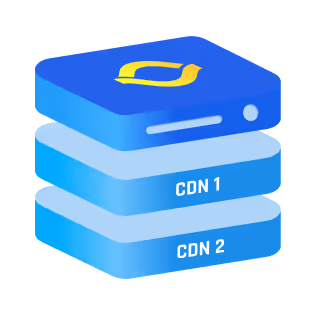Should My Company Implement a Cloud WAF Solution?
Table of contents
Yes; unless you operate a zero-risk, purely internal site, you almost certainly need a cloud WAF solution today. You’re serving code that changes weekly, attackers invent new exploits hourly, and the record-breaking HTTP/2 “Rapid Reset” wave peaked at 7.3 Tbps.
If you stay on a traditional web application firewall appliance you own, you end up patching signatures by hand and hoping your pipe is wider than the next botnet.
A cloud-based web application firewall shifts that burden upstream: the provider absorbs the flood, ships rules minutes after a CVE drops, and lets you dial protection on with an API call while your devs sleep.
Why Do You Need a WAF?
You run public HTTP/S endpoints: login forms, REST APIs, GraphQL, maybe a forgotten PHP admin panel from 2017. Every one of those is a door an attacker can kick.
You handle it today with input validation and pen-testing, but I’ll bet half your apps still log raw SQL errors in staging. A WAF is the bouncer on the curb: it spots the fake IDs, throttles the guy waving 100 000 requests a second, and says “not tonight” to any payload that looks like {"$ne":""}.
Threat math you can’t ignore
- SQL/OGNL/XSS payloads are commodity.
- Automated vulnerability scanners run 24×7.
- DDoS keeps scaling; Cloudflare mitigated a 7.3 Tbps blast in May 2025.
You can’t code fast enough to outpatch that alone.
What Changes in Appliance vs Cloud?
You might already own a web application firewall appliance; an F5, Fortinet, Barracuda box humming in the rack. That hardware still filters traffic, but it suffers three structural limits:
A cloud WAF (WAF in the cloud, a waf cloud model) sits in front of every endpoint no matter where you host it (on-prem, AWS, an obscure VPS).
You CNAME or reverse-proxy through their edge network and stop thinking about bandwidth graphs.
Day-One Benefits of a Cloud WAF Solution
Let’s talk numbers:
- Elastic DDoS shield
The biggest volumetric floods now measure in terabits; multi-tenant WAF clouds ride petabit backbones and scrub at layer 3–7 before the junk ever nears your zone. - Instant zero-day coverage
When Log4Shell or the Rapid Reset bug hits, the provider rolls out a global patch while you’re still reading Hacker News. - API-first ops
You toggle a rule, drain logs to SIEM, or stage a “block China” experiment with Terraform. No more SSHing into appliances after a change window. - Performance perks for free
Most vendors bundle CDN caching, HTTP/3, Brotli, and TLS 1.3 termination. You shave 200 ms off TTFB and claim you “optimized” page speed. - Compliance checkboxes
PCI DSS 4.0 now calls out WAAP controls explicitly. A managed cloud WAF solution hands you audit reports and SOC 2 line items without extra consultants. - Cost fold-down
Your cap-ex appliance refresh every three years morphs into opex pennies per million requests.
Questions to Ask For Your Company
Answer “yes” to three or more, and you’re already late to deploy.
- How many public origins do you expose?
More than two? You benefit from a central policy plane. - Does your traffic ever spike 10×?
Launch-day flash sales, press hits, GitHub trending; cloud beats 1 GbE copper every time. - Can you patch CVEs within 24 h?
If that SLA scares you, outsource it. - Do you need bot management or API abuse throttling?
Advanced WAF clouds bundle behavioral ML that would take you months to train. - What compliance letters do customers demand?
A top-tier vendor ships PCI-AOC, ISO 27001, SOC 2, HIPAA, and sometimes FedRAMP. - Where do you keep logs today?
If Splunk ingest costs more than pizza, funnel sampled WAF JSON to S3/BigQuery. - Who will own tuning and exceptions?
Name a person. If nobody volunteers, pick a fully-managed plan.
What About On-Prem, Edge Cases?
There are still reasons to keep a web application firewall appliance:
- Ultra-low-latency trading where every millisecond pays.
- Sovereign clouds that forbid outside IP transit.
- Air-gapped sites or classified workloads.
Even then, pair the appliance with a cloud WAF solution in front of public marketing pages; it offloads noise so the box handles only vetted sessions.
Regulatory Squeeze
You no longer get weeks to investigate quietly. Since late 2024, the U.S. SEC forces public companies to disclose any material cyber incident within four business days of confirming impact.
A cloud WAF that blocks exploits at the edge can keep a headline-grade incident from ever becoming “material” in the first place; and if something does sneak through, your WAF logs give you the forensic paper trail you must file.
Across the Atlantic, GDPR fines keep climbing: the cumulative total hit €5.88 billion by January 2025, with single-company penalties topping €1.2 billion.
A modern cloud-based web application firewall lets you enforce geo-fencing, inspect data-leak patterns, and prove “appropriate technical controls” to regulators without buying a second hardware farm in the EU.
Costs of a Good Cloud WAF Solution
Let’s crunch some numbers:
Hidden-but-huge line items the spreadsheet rarely shows
- Breach exposure – Every blocked exploit is a lottery ticket you don’t have to cash.
- Downtime tax – One fifty-minute DDoS that your on-prem box can’t absorb erases the purchase-price “savings” in a single afternoon.
- Cyber-insurance premiums – Underwriters cut rates when you show “managed WAF in place.” I’ve watched policies drop 8–10 % after proof of a cloud WAF.


.png)
.png)
.png)